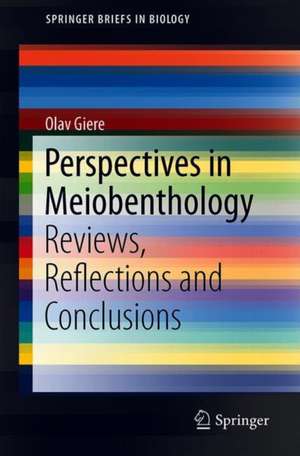Perspectives in Meiobenthology: Reviews, Reflections and Conclusions: SpringerBriefs in Biology
Autor Olav Giereen Limba Engleză Paperback – 8 apr 2019
Preț: 355.71 lei
Nou
Puncte Express: 534
Preț estimativ în valută:
68.07€ • 70.81$ • 56.20£
68.07€ • 70.81$ • 56.20£
Carte disponibilă
Livrare economică 25 martie-08 aprilie
Livrare express 08-14 martie pentru 21.44 lei
Preluare comenzi: 021 569.72.76
Specificații
ISBN-13: 9783030139650
ISBN-10: 3030139654
Pagini: 105
Ilustrații: X, 80 p.
Dimensiuni: 155 x 235 x 14 mm
Greutate: 0.14 kg
Ediția:1st ed. 2019
Editura: Springer International Publishing
Colecția Springer
Seria SpringerBriefs in Biology
Locul publicării:Cham, Switzerland
ISBN-10: 3030139654
Pagini: 105
Ilustrații: X, 80 p.
Dimensiuni: 155 x 235 x 14 mm
Greutate: 0.14 kg
Ediția:1st ed. 2019
Editura: Springer International Publishing
Colecția Springer
Seria SpringerBriefs in Biology
Locul publicării:Cham, Switzerland
Cuprins
Introduction.- Chapter 1: Fields of general relevance and broad public interest.- Chapter 2: Pollution and Meiofauna.- Chapter 3: Future ecological trends in meiobenthos research.- Chapter 4: Physiology, biochemistry and meiofauna – a rarely touched realm.- Chapter 5: Towards and integrated triad – taxonomy, morphology, and phylogeny.- Epilogue.
Notă biografică
Textul de pe ultima copertă
Although of high abundance, diversity and ecological importance, meiofauna is little covered by relevant scientific media. How can this negligence be overcome? The present treatise highlights promising meiofauna research fields, selected both from basic and applied science, as well as new methods that could strengthen the potential of meiobenthology. Selected recent meiofauna studies, often supported by rapidly advancing gene-based methods, underline the relevance and potential of meiobenthology revealing characteristics and harassments of ecosystems, not the least in extreme habitats. Also in the more classical domains such as taxonomy and phylogeny, progress in meiobenthos research defines a new and deeper scientific understanding.
Caracteristici
Summarises progress in meiobenthos research for a more integrative scientific understanding Highlights promising meiofauna research fields from basic and applied sciences Discusses ways to draw more attention to the research on microscopic benthic animals Underlines the relevance of meiobenthos as naturally interacting partner between the worlds of microbes and macrofauna









